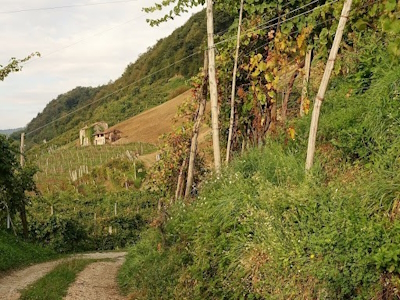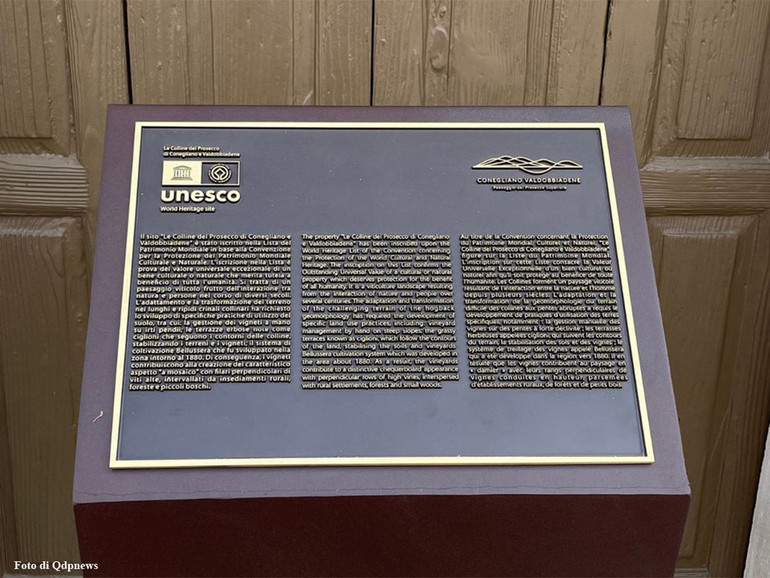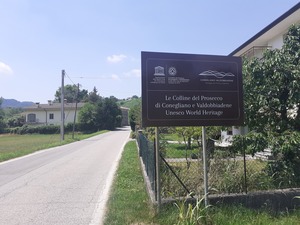The Prosecco Hills

Le Colline del Prosecco di Conegliano e Valdobbiadene form a viticultural landscape in challenging, mountainous terrain.
The highest quality Prosecco, an extra dry sparkling white wine, has been produced here since the 18th century. The vineyards had to be managed on steep slopes; it was done by using grassy terraces (ciglioni) and applying the bellussera method to get the maximum out of the lands.
Community Perspective: We can count on Clyde and Hubert to seriously investigate these sparkling white wines. They both named Rolle as the best place to see the steep terraces.
Map of The Prosecco Hills
Community Reviews
Hubert

Oh no, not another vineyard. That was my first thought when the Prosecco Hills were inscribed on the World Heritage list in 2019. Not really an enthusiastic reaction. But is it justified? Well, vineyards are an over-represented category. But we are in Italy, so good food can be expected and I can taste a wine I didn't know well before. Reasons enough to spend a long weekend in the Veneto and tick off a new WHS. So in September 2021, I set off on a 5-hour drive to the Prosecco Hills.
The inscription was highly controversial, a secret ballot was needed to overrule the "not inscribe" recommendation by ICOMOS in 2018. One year later, an amended proposal with a significantly reduced core zone was inscribed.
The focus is on the scenic landscape with its steep vineyards and small hilltop villages. The production sites and wine cellars are not explicitly mentioned in the description and obviously do not contribute to the OUV of the site. In this respect, the Prosecco Hills differs, for example, from the French "Champagne Hillsides, Houses and Cellars". The larger villages at the foot of the steep hills are not included, nor are the eponymous towns of Conegliano and Valdobbiadene. And rightly so, the cultural heritage here - historic town centres, churches and monasteries - is not outstanding and is below the level of other World Heritage sites in Italy.
I got a first impression of what is special about the Prosecco hills when I left the main road (SP4) in Follina and drove up into the core zone. A first stop was in Rolle, a picturesque hilltop village. From the terrace in front of the church you have a wonderful view of the steep vineyards and the hilly landscape. A few kilometres further and you reach the Molinetto della Croda, very popular with tourists, but a little too kitschy for my taste.
The main destination of my weekend trip was the region near Valdobbiadene, specifically the Cartizze area. Cardizze is an area of only about 100 hectares where the grapes for the supposedly best Prosecco grow. At least in Italy and especially in the Veneto, it is the most sought-after Prosecco and the most expensive, also because it is so rare. And Cartizze is also said to have the steepest vineyards and the most beautiful hills.
I picked up a map with a suggested hiking route at the tourist information in Valdobbiadene and started my hike in the village of Saccol. The map was not very detailed and the route was not well signposted. At the beginning it followed the main road to Santo Stefano, but most of the route went alongside the vineyards or right through them. A few times I had to deviate from the suggested route because there was a fence where I didn't expect one or a bridge over a ditch was missing where there should have been one. And once I had to avoid two angry guard dogs that obviously didn't know that the trail ran through their territory. All in all, I very much enjoyed my hike through the Cartizze vineyards. But it was a lot of uphill-downhill hiking, the slopes are really steep.
After my visit, I still doubt that the inscription added much value to the WH list. Picturesque vineyards on steep slopes are not enough to prove OUV, there are just too many of them on the list already. However, I spent a very pleasant weekend in the Prosecco Hills, I enjoyed the landscape, the food and of course the Prosecco.
I stayed at the B&B Alla Pergola in Saccol/Valdobbiadene, which I can highly recommend, especially because of the adjacent restaurant. The breakfast was sumptuous, with local specialities and homemade cakes. But be aware that local specialities in the Veneto basically mean prosciutto, speck and meat.
Els Slots

I was badly in need of a weekend trip to Italy after 1.5 years of drought on that usually enjoyable travel front. I had hoped for a positive evaluation of Bologna for the 2020/2021 WHC session, as the university city itself appealed to me (the Porticoes not so much). But that wasn’t the case and I turned instead to the Prosecco Hills, my last remaining ‘tick’ in Italy. The Prosecco Hills lie in the foothills of the Alps. So far up north, this isn’t the elegant, bright, artistic and life-loving Italy anymore. It’s more like an Austrian/German farmers’ region, with the restaurant menu heavy on game meat.
I stayed overnight in the city of Vittorio Veneto, easy to reach by train from Venice. It lies directly to the northeast of the inscribed area of the Prosecco Hills. Which leads me to point out the terrible quality of the map belonging to this WHS. Only when you zoom in to the max and have great eyes, you’ll know what is inscribed and what isn’t.
For my WHS visit I took a bus to Follina, some 25km further along road SP635/SP4 a.k.a. the “Strada del Prosecco”. Bus 117 leaves Vittorio Veneto every 1.5 – 2 hours daily. I got out in the town center. Follina has a few picturesque old houses and a large basilica, which is being restored at the moment. This town as well as all the others of a size above a rural village are excluded from the core zone.
I then walked for a bit in the direction of the hills to the left of the road. Most are covered by forest, there are a few patches here and there with intricately woven vines and a small shed next to it. On this side of the hill, the locals surely did not go out of their way to clear the forest or beat the steep hilltops into submission to create vineyards. The other side of the ridge may be more impressive from that perspective, but without a car, it is hardly doable to reach them.
Established where the core zone is – Check. Now what to look out for to see its OUV? It’s not enough to look at some grapevines. The explanations given in the AB evaluation and nomination dossier dazzle you with scientific terms: these aren’t ordinary rocky ridges but “hogback hills” instead. If you weave your vines in a specific pattern, that’s called bellussera. And ciglioni aren’t a regional type of pasta but narrow grassy terraces. It did not convince me at all and I cannot conclude differently that this is Italy’s worst WHS.
This site could almost have been added to our connection Controversial at the inscription. It received a “Not to inscribe” advice from ICOMOS in 2018, but that was argued back to a Referral by the WHC. Surprisingly, ICOMOS returned with positive advice a year later. The superficial changes made include a focus on the rural landscape instead of the viticultural aspects. Also, the core zone was diminished to only include a mostly uninhabited ridge.
Clyde

I visited this WHS in July 2019 on a whim to keep Italy complete. As such it will always have a special place in my memories as I was listening to its inscription on the WH list in my car, literally while reaching Valdobbiadene. Having visited what in my opinion are Italy's best vineyard WHS, famed for its red wines, we didn't mind heading to Valdobbiadene-Conegliano after Cannelli/Asti to taste more of Italy's sparkling white wines.
The valley between Valdobbiadene and Conegliano is covered with vineyards and dotted with small villages (not comparable to the ones in Piedmont). I used a local winegrower's B&B near Valdobbiadene as my base for 3 days where I learnt that the best category of Valdobbiadene-Conegliano prosecco comes from the Cartizze area, at the foot of the Cesen mountain (1570m - nice panoramic view for sunset). The Cartizze area has an ideal microclimate which gives the best expression to the Glera grapes and hence the special organoleptic characteristics of prosecco's 'Grand Cru'. This is mainly thanks to its sun exposition, its ventilation, its soil and its temperature variation. The Cartizze valley hills rise from 200 metres to 350 metres above sea level. The steep hills are facing south, meaning that virtually every vine is always exposed to sunlight and is never affected by the shadow of the vines in front, giving the grapes the opportunity to mature evenly and with a higher sugar content than in any other prosecco production area. Moreover, there's a constant light breeze blowing from the North East, which dries the leaves of the vines, eliminates humidity and prevents diseases such as blight and mildew. Thus, less pesticides are needed here compared to the rest of the inscribed area, which was something that was passionately highlighted just before inscription by a member of World Heritage Watch.
Valdobbiadene and Conegliano are the largest towns in the Strada del Prosecco. Apart from the Istituto Sperimentale per la Viticoltura where several Italian grape varieties have been bred and the remains of a castle, Conegliano and its surroundings felt much more urban and less picturesque in a way. Perhaps this is due to its proximity to the city of Treviso, some 30km away (train is a viable option if you travel from Treviso but a car or long distance hiking are necessary to cover more ground and actually appreciate the vineyards - there are no pavements along the SP36 which is possibly the best vantage route to take in the Valdobbiadene-Conegliano Prosecco Hills. Cison di Valmarino and Follina are two quaint towns listed among I Borghi più belli d'Italia (and rightly so). The Chiostro Romanico (1268) in Follina was free of charge when I visited and definitely worth a stop. The hike through the vineyards near the Chiesa di San Lorenzo near Farra di Soliga offers breathtaking views all day round especially in sunny weather.
Other viewpoints worth mentioning are the ones just outside Frazione di Santo Stefano (here you can try something different at the Osteria Senz'Oste; a sort of healthy version of a McDrive but with cold cuts, cheeses and prosecco of course) and from San Pietro di Barbozza just after Valdobbiadene. Another route worth exploring by car is along the SP152, with my personal highlight being Rolle (photo) and the touristy but sweet Mulinetto della Croda nearby.
All in all I enjoyed my visit and I'll give it a pass mark because of the experience even though I struggled to find any true OUV. It is more of a niche site or a national heritage site especially when considering the other cultural and natural WHS nearby.
Nan

One of the charms (or challenges) of visiting tentative sites is that the usual tourist infrastructure is missing. No visitor center, no heritage trails, little to no signposting, no official website ... And worse, as it’s still a nomination neither the boundaries nor locations are finalized. So I was left wondering what the proposed site "Prosecco Hills of Conegliano and Valdobbiadene" entailed and what to visit. I found the nomination to be rather unhelpful in that respect.
One site that is mentioned and that can be visited easily is the Convitto Scuola Enologica in Conegliano. It is based in a 19th-century manor on the outskirts of town and supports to this day the local vineyards in growing the Glera grape.
From there you can travel onward into the main hills between Conegliano and Valdobbiadene. I googled a bit and found a trail in Premaor, more or less in the middle of the region. So I hopped on a bus and went on a hike in the hills. The trail was poorly signposted (see above) so I missed out on a Chateau along the way and had to walk back along the main road (not so nice). After 2h I decided to call it a day and headed back to Conegliano.
If the Piedmont Vineyards were the threshold, the Prosecco Hills should have been inscribed the first time around. The viticulture university offers actually some uniqueness. But I hope to have made abundantly clear in both my review and with my rating: I don’t think the Piedmont Vineyards belong on the list. And neither do the Prosecco Hills. It’s yet another run of the mill vineyard.
But what I (and more importantly ICOMOS) consider as having no OUV has been of little importance to the WHC it seems. So I wouldn’t bet against the Prosecco Hills making the list eventually.
[Update July 2019] And indeed, the Prosecco hills are now inscribed. This one got me sweating as the site was greatly reduced from the nominated area. Conegliano including the viticulture school is no longer part of the site. It's really only about the hill.
I spent some time with the dossier to conclude the hills around Premaor (not Premaor) is just within the core zone. Really close call.
Getting There
Conegliano is well connected by train with Venice and the rest of Italy. If you are arriving from the Dolomites (Cortina), things get a bit trickier, especially on the weekend when no trains run, but plenty of car traffic goes in and out of the mountains.
Plenty of buses run from Conegliano to the hills. Buying tickets on the bus is possible but more expensive. I couldn't figure out, though, where to buy the tickets otherwise.
While You Are there
Conegliano is the usual nice and pleasant Italian town. If Venice gets way too expensive you could consider commuting from here by train.
Community Rating
- : Lisu Marian Yevhen Ivanovych Rafał Kałczuga
- : Fabian Teusch
- : PabloNorte
- : Jeanne OGrady JobStopar WILLIAM RICH Christoph Ivan Rucek
- : Randi Thomsen Craig Harder Feldhase WalGra Hasco Svein Elias
- : Clyde Alexander Barabanov Jakob Frenzel Csaba Nováczky Dorejd Paolosan82 Hubert Cezar Grozavu Deffra Daniel C-Hazard Martina Rúčková
- : Tarquinio_Superbo Dwight Zehuan Xiao Luis Filipe Gaspar Alexander Lehmann Frederik Dawson Riccardo Quaranta Jezza Mihai Dascalu David Berlanda Argo Luboang Frédéric M
- : Lucio Gorla MH
- : Stanislaw Warwas Philipp Peterer Ralf Regele Zoë Sheng CugelVance Jeffrey Chai Ran Jasam Federico P. Els Slots
- : Solivagant Nan Petteri Wojciech Fedoruk
Site Info
- Full Name
- Le Colline del Prosecco di Conegliano e Valdobbiadene
- Unesco ID
- 1571
- Country
- Italy
- Inscribed
- 2019
- Type
- Cultural
- Criteria
-
5
- Categories
- Cultural Landscape - Continuing
- Link
- By ID
Site History
2019 Inscribed
2018 Advisory Body overruled
ICOMOS advised Not to inscribe; amendment to Inscribe voted against 9-12 in secret ballot (no 2/3 majority). Finally overturned to a Referral after much debate, including a Deferral amendment lead by Australia.
2018 Referred
Site Links
Unesco Website
Official Website
Connections
The site has 11 connections
Art and Architecture
History
Human Activity
Science and Technology
Timeline
WHS Hotspots
WHS Names
World Heritage Process
Visitors
128 Community Members have visited.
The Plaque
 (external source)
(external source) (photo by Jarek)
(photo by Jarek)